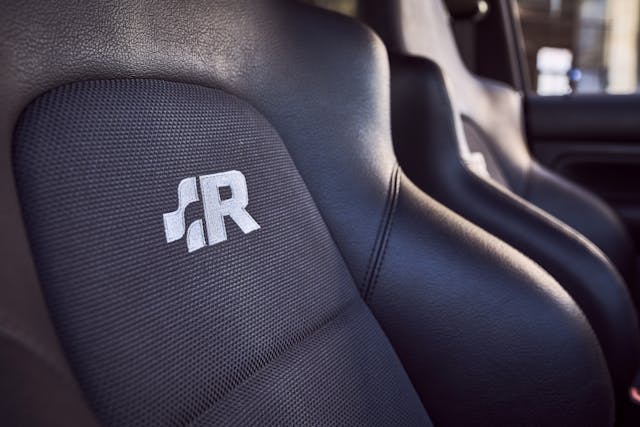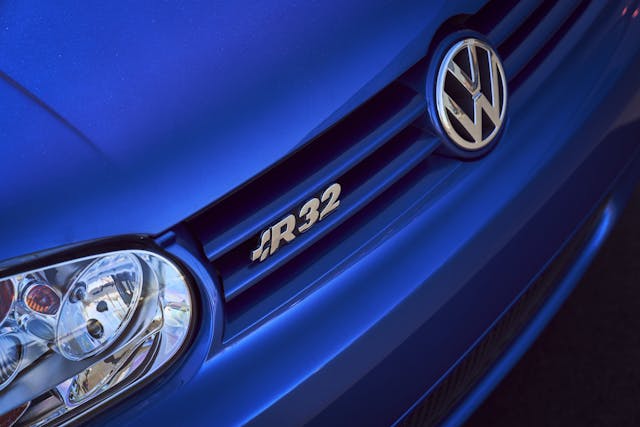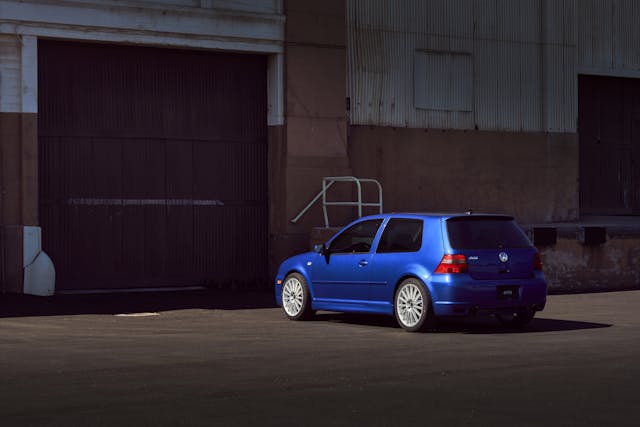The Cheap Mk IV R32 Is Dead. Long Live the R32
Twenty years after it debuted, the hatchback that defined the template for the top-dog Golf in the U.S. is no longer cheap. VW’s Mk IV R32 is, more clearly than ever, a bonafide collector car. Even in a market that continues to cool, this all-wheel-drive hatch is red hot, forging its place in the pantheon of 2000s classics.
A lot has happened since 2004, the only model year that VW offered this über-Golf in the United States. To refresh your memory: That year, Mark Zuckerberg launched TheFacebook.com. Shrek 2 landed in theaters. The Spirit and Opportunity rovers landed on Mars. And Volkswagen allocated 5000 examples of the hottest hatchback it had ever made to the United States.
Stateside car enthusiasts already knew how much fun a VW hot hatch could be. In 1983, we met the Mk I Rabbit GTI, a 90-hp, four-cylinder featherweight that put a grin on your face every time you tossed it down a curvy road. Enthusiasts fell in love with the GTI for the quality of its steering, the balance of its chassis, and its understated practicality.
As of its fourth generation, which arrived in the U.S. for the 1999 model year, the sportiest Golfs had grown bloated. VW compensated for the increased heft and size with more power, including a 174-hp, VR6-powered model called the GLX, but reviews were scathing: Car and Driver wrote that the GLX “leaned in corners like a torpedoed frigate,” and declared the howling from its sidewalls “a defilement of the memory of the original hot-hatch Rabbit.” The 2.0-liter, turbocharged four-cylinder GLS that VW added for 2000 wasn’t any more aggressive.


With the R32, Volkswagen finally got the recipe right for a more substantial Mk IV. VW didn’t simply add power: It added an all-wheel-drive system derived from another Volkswagen Group product, the TT 3.2 quattro, lowered the suspension by an inch, and added huge, 13.1-inch front brakes. Like the GLX, the R32 was powered by a naturally aspirated VR6, VW’s narrow-angle V-6, but in the R32 it was enlarged to 3.2 liters, the largest displacement for any production Golf to date. Tuned to 240 hp, the VR6 in U.S.-market cars was backed exclusively by a six-speed manual. (European market cars got a dual-clutch automatic, the first of any production car.) Aluminum pedals, König sport seats, a dual exhaust, and a set of 18-inch, 15-spoke alloy wheels ensured that the car felt, looked, and sounded like something special. The front suspension bushings and spindles borrowed from the TT brought the handling in line with the expectations set by the original GTI: Car and Driver called the R32 “the funnest ‘Audi’ VW has ever sold.”
Though it was not the most powerful of the cheap, fun competition, the R32 set itself apart in restraint and maturity. Unlike the competition from Mitsubishi, Subaru, and Honda, the sportiest Golf wore neither wing nor scoop. A three-letter badge or a stripe of red had been sufficient for the GTI, and the R32 was extreme only by the restrained standards of the Germans: With a gaping lower air dam, badges for the grille and trunk, and darkened taillights above a dual exhaust, it radiated a quiet confidence. 20 years later, the softly flared fenders and chunky door handles communicate that same maturity, dipped in 2000s nostalgia.

That nostalgia, coupled with attrition and low production numbers, is a huge reason behind the skyrocketing prices of the R32. These cars were so fun to drive that many people did just that, without regard to the rock chips or wheel rash or fender-benders that cause today’s most discerning R32 collectors to recoil. As of 2020, the average mileage of all R32s offered on Bring a Trailer was over 73,000, with many closing in on 150,000 miles. Because immaculate R32s are hard to find, the best examples have sold for increasingly eye-watering prices: $65,100 for an 1800-mile car in August of 2020, $61,950 for a 20,000-mile example in November of 2021, then $104,000 for a 97-mile one in February of 2023.
One hundred grand?
For a 97-mile car with a shower cap still on the steering wheel, yes. The best-condition cars (#1 and #2) have appreciated at a more aggressive rate than their driver-quality (#3 and #4) siblings. This bears out a pattern we’ve observed in the entire collector-car market: The value gap between the best-condition cars and the less-perfect rest is widening, in large part because it’s getting more expensive to bring a lesser-condition car up to snuff.

Values for the R32 peaked in the summer of 2023, even as the market continued to fall from its 2021 heights: In July, the Hagerty Market Rating, which evaluates the activity of the broader collector-car market, posted its largest single-month drop in over three years. The R32 cared not: The value of a #2 (Excellent) condition example jumped from $35K in April of 2023 to $54,600 in July. As of this writing, values for #1 and #2 cars have found a new normal, with average values remaining stable at $73,300 and $54,600. #3 and #4 condition cars retreated $3000 and $2300, respectively, from July to October of last year, though as of January, 2024, those figures are holding steady.
The divergence of values between the best cars and the rest has a silver lining: Well-worn examples have not appreciated as much as their low-mile brethren. If you’re willing to show some TLC to an example that is rough around the edges, you can still find an R32 in the $20K range, and even a #3 (Good) condition car with minimal needs sits at 30 grand. Our suggestion, for R32 fans on a budget? Don’t chase perfection: Invest enough in the car to make it the delightful driver it is, shop freely from the catalog of standard Golf and VW Group parts (only a few interior trim pieces are unique to the R32), and have fun. And, not to take away from this exclusive hatch, but there is always the Audi TT 3.2 Quattro, which fields the same driveline, albeit in a different tune; it’s available for far less.
Enthusiasts are lining up to realize their dreams of the early 2000s: Quote counts for the R32 are steadily increasing. Buyer demographics skew heavily to the generations that coveted them when new, or to young buyers who look back at them with reverence: Gen X and younger account for 88.9 percent of the interest of these cars. (For context, these buyers represent 63 percent of the broader collector-car market.) Never mind the fact that TT 3.2 Quattro has a similar driveline and costs less: There is a special something about this 2000s hatchback.
Coveted by a young demographic, and riding a wave of 2000s nostalgia, the R32 isn’t looking like it will get cheaper. The days of the perfect, $30K R32 are gone; but VW’s hottest Mk IV hatch is here to stay.

***
Check out the Hagerty Media homepage so you don’t miss a single story, or better yet, bookmark it. To get our best stories delivered right to your inbox, subscribe to our newsletters.



A very well written article that describes the last era of great driving vehicles.
Once car manufacturers let the nerds take over braking with drive by wire and driving aids that are like having the ex-wife in the backseat along with really questionable styling, cars are now just gross.
Keep driving these classics. Love it.
Actually, there are PLENTY of great-driving vehicles now (and some even look good), if we just open our eyes – and our minds.
Great cars and they look fantastic in that shade of blue.
Repackaging the Audi TT into the Golf makes a nice grocery-getter. Like buying the milk instead of the cow. The question is, why buy a grocery-getter if you want the Audi TT experience?
This pumped-up Golf misses the mark. Overpriced, overweight and overpowered just doesn’t equate to hot-hatch minimalist fun. VW and pretty much all the other players (yes I mean you, Honda) in the former hot hatch game need to rise to the challenge of bringing back the authentic bare-bones (sorry, no heated, power seats, no leather trim, no touch screen dash) hot hatch experience.
And in today’s world/market, how many – realistically – would buy such a car?
Not everyone can fit comfortably in an Audi TT. The Golf offers a lot more room and practicality over that car. Even a TT Roadster is a tight fit legs-wise for a tall man like myself. Your sentiments on the MkIV generation of Golf/GTI echo the criticism of the time, however—that the car had gotten too heavy, bloated and underpowered. Compared to contemporary cars, though, they’re tiny, light and less crammed with nanny systems.
Cars from this era will continue to rise in popularity and value as they represent the last gasp of the analog, naturally-aspirated era of internal combustion vehicles. I’m with Hagerty: Long Live the R32.
Couldn’t agree more with BG95PreludeSRV. I gave up on the hobby when car makers started adding useless, luxury features like electric start, automatic spark advance, and hydraulic brakes…I too am waiting for the day manufacturers to bring back that bare-bones fun. 😉
Hydraulic brakes?!? They first ruined it with those darn front-wheel brakes!
It helps to have been around when dinosaurs roamed the planet.
The interior photo shows the inside of a MkV R32. All the other images are of a MkIV R32, which is the gen that’s gone crazy. The MkV can still be bought at reasonable prices, though values are increasing as the MkIVs go outta sight.
thanks for the close eye!
Wolf and mare. Unfortunately you are wrong. The interior picture is of a Mk4 set of super comfortable Konig seats – I know as I own a UK Mk4 R32.
No, I was correct. The seats and dashboard were clearly from the MkV R32.
Just to clarify: Hagerty removed the photo that I noted was incorrect. The interior photo now pictured shows the correct Konig seats.
There are plenty of stripped down, lower weight cars. They’re called Superleggeras and all you have to do is pay a premium and wait for delivery. Or you could avoid that bucket of the colonels finest and skip the after dinner hoagie instead of overpaying for titanium paddle shifters. I agree with Rider79. It’s much the same as people who say – ‘ They don’t make good music anymore ‘ . Try tuning in to your local college station. You’ll be surprised at what’s out there out of the mainstream.
So are you saying Colin Chapman was wrong?
I’ve got one “turbocharged “
That is one you want
I own a MKIV GTI R 20 anniversary edition which was factory fitted with all the R32 trimmings, however the 1.8t AUQ powertrain. Interesting to see what the value of these vehicles will do in future. A limited 250 units were manufactured in 2004.
There was no 2.0 liter turbocharged engine for MK4. The turbo engine released in 2000 for the MK4 was the 1.8T. The 2.0T didn’t come out until 2005.5 for the US MK5